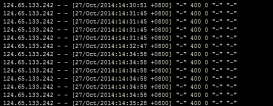Nginx(engine X) 是一个高性能的 HTTP 服务器和反向代理服务器,这款软件开发的目的是为了解决 C10k 问题。
Nginx 的架构利用了许多现代操作系统的特性,以实现一个高性能的 HTTP 服务器。例如在 Linux 系统上,Nginx 使用了 epoll,sendfile,File AIO,DIRECTIO 等机制,使得 Nginx 不仅性能高效,而且资源占用率非常低,官方宣称 nginx 维持 10000 个非活动的 HTTP keep-alive 连接仅需要 2.5M 内存。

Nginx会按需同时运行多个进程:一个主进程(master)和几个工作进程(worker),配置了缓存时还会有缓存加载器进程(cache loader)和缓存管理器进程(cache manager)等。所有进程均是仅含有一个线程,并主要通过“共享内存”的机制实现进程间通信。主进程以 root 用户身份运行,而worker、cache loader 和 cache manager 均应以非特权用户身份运行。
1. 安装 nginx
在 CentOS6 版本的 EPEL 源中,已经加入了 nginx 的 rpm 包,不过此 RPM 包版本较低。如果需要更新版本,可以使用官方制作的 rpm 包,或者使用源码包编译安装。
还可以使用一些二次开发功能增强的 nginx 版本,例如淘宝的 Tengine 和 OpenResty 都是不错的选择。
1.1 常用编译参数
--prefix=PATH:指定 nginx 的安装目录
--conf-path=PATH:指定 nginx.conf 配置文件路径
--user=NAME:nginx 工作进程的用户
--with-pcre:开启 PCRE 正则表达式的支持
--with-http_ssl_module:启动 SSL 的支持
--with-http_stub_status_module:用于监控 Nginx 的状态
--with-http-realip_module:允许改变客户端请求头中客户端 IP 地址
--with-file-aio:启用 File AIO
--add-module=PATH:添加第三方外部模块
这里提供一个完整的编译方案:
--prefix=/usr/local/nginx \
--conf-path=/etc/nginx/nginx.conf \
--error-log-path=/var/log/nginx/error.log \
--http-log-path=/var/log/nginx/access.log \
--http-client-body-temp-path=/var/tmp/nginx/client_body \
--http-proxy-temp-path=/var/tmp/nginx/proxy \
--http-fastcgi-temp-path=/var/tmp/nginx/fastcgi \
--http-uwsgi-temp-path=/var/tmp/nginx/uwsgi \
--pid-path=/var/run/nginx.pid \
--lock-path=/var/lock/nginx \
--user=nginx \
--group=nginx \
--with-file-aio \
--with-http_ssl_module \
--with-http_realip_module \
--with-http_sub_module \
--with-http_gzip_static_module \
--with-http_stub_status_module \
--with-pcre
1.2 nginx 的启动和关闭
启动 nginx:
|
1
|
# nginx -c /etc/nginx/nginx.conf |
关闭 nginx
|
1
|
# nginx -s stop |
重读配置文件
|
1
2
|
# nginx -s reload# pkill -HUP nginx |
重新打开日志文件
|
1
2
|
# nginx -s reopen# pkill -USR1 nginx |
还可以下载 nginx RPM 包中的 /etc/init.d/nginx 文件,修改路径后即可使用:
|
1
|
# service nginx {start|stop|status|restart|reload|configtest|} |
2. nginx.conf 配置文件
Nginx 配置文件主要分成四部分:main(全局设置)、http(HTTP 的通用设置)、server(虚拟主机设置)、location(匹配 URL 路径)。还有一些其他的配置段,如 event,upstream 等。
2.1 通用设置
user nginx
指定运行 nginx workre 进程的用户和组
worker_rlimit_nofile #
指定所有 worker 进程能够打开的最大文件数
worker_cpu_affinity
设置 worker 进程的 CPU 粘性,以避免进程在 CPU 间切换带来的性能消耗。如 worker_cpu_affinity 0001 0010 0100 1000;(四核)
worker_processes 4
worker 工作进程的个数,这个值可以设置为与 CPU 数量相同,如果开启了 SSL 和 Gzip,那么可以适当增加此数值
worker_connections 1000
单个 worker 进程能接受的最大并发连接数,放在 event 段中
error_log logs/error.log info
错误日志的存放路径和记录级别
use epoll
使用 epoll 事件模型,放在 event 段中
2.2 http 服务器
server {}:
定义一个虚拟主机
listen 80;
定义监听的地址和端口,默认监听在本机所有地址上
server_name NAME [...];
定义虚拟主机名,可以使用多个名称,还可以使用正则表达式或通配符。
sendfile on
开启 sendfile 调用来快速的响应客户端
keepalive_timeout 65
长连接超时时间,单位是秒。
send_timeout
指定响应客户端的超时时间
client_max_body_size 10m
允许客户端请求的实体最大大小
root PATH
设置请求 URL 所对应资源所在文件系统上的根目录
location [ = | ~ | ~* | ^~ ] URI { ... }
设置一个 URI 匹配路径
=:精确匹配
~:正则表达式匹配,区分字符大小写
~*:正则表达式匹配,不区分字符大小写
^~:URI 的前半部分匹配,且不实用正则表达式
优先级:
= > location 完整路径 > ^~ > ~ > ~* > location 起始路径 > location /
allow 和 deny
基于 IP 访问控制,如:
仅允许 192.168.0.0/24 网段客户端访问
allow 192.168.0.0/24;
deny all;
stub_status on
开启状态显式,仅能用于 location 中:
开启状态显式页面
|
1
2
3
4
5
|
location /status {stub_status on;allow 172.16.0.0/16;deny all;} |
rewrite <REGEX> <REPL> <FLAG>
URL 重写,可以使用多种标记
例如:
rewrite ^/images/(.*\.jpg)$ /imgs/$1 break;
可用的 flag:
- last:重写完成后,继续匹配其他 rewrite 规则
- break:重写完成后不再继续匹配
- redirect:返回 302 重定向(临时重定向),客户端对重定向的 URL 发起新的请求
- permanent:返回 301 重定向(永久重定向),客户端对重定向的 URL 发起新的请求
一个 server 配置示例:
|
1
2
3
4
5
6
7
8
9
10
11
12
13
14
15
|
server { listen 80; server_name www.example.com; root /web/htdocs; location / { index index.html index.htm; } location /status { stub_status on; allow 10.0.0.0/8; deny all; access_log off;} |
2.3 SSL 的配置
启用一个 SSL 虚拟主机
|
1
2
3
4
5
6
7
8
9
10
11
12
13
14
15
16
|
server { listen 443; server_name example.com; root /apps/www; index index.html index.htm; ssl on; ssl_certificate /etc/nginx/ssl/nginx.crt; ssl_certificate_key /etc/nginx/ssl/nginx.key;# ssl_protocols SSLv3 TLSv1 TLSv1.1 TLSv1.2;# ssl_ciphers ALL:!ADH:!EXPORT56:RC4+RSA:+HIGH:+MEDIUM:+LOW:+SSLv2:+EXP;# ssl_prefer_server_ciphers on;} |
其中 ssl_certificate 表示 CA 文件,ssl_certificate_key 表示密钥文件。
如果想把 http 请求强制转到 https,可以这样:
|
1
2
3
4
5
6
|
server {listen 80;server_name example.me;return 301 https://$server_name$request_uri;} |
2.4 nginx 做负载均衡反向代理
nginx 做反向代理时,后端主机有多台,可以使用 upstream 定义一个后端主机池,在反向代理时直接使用主机池的名字。在 upstream 中可以定义负载均衡调度算法,权重,健康状态检测等参数。
例如:
|
1
2
3
4
|
upstream backend { server 172.16.0.1:80 weight=1 max-fails=3 fail_timeout=10; server 172.16.0.2:80 weight=1max-fails=3 fail_timeout=10;;} |
默认请求下,使用 round-robin 调度算法,并有健康状态检查和恢复主机的能力。
ningx 还可以使用这些算法:
ip_hash:基于源地址哈希,主要目的是会话保持
least_conn:基于最少活动连接进行调度
sticky:基于 cookie 进行会话绑定,nginx 会在客户端第一次访问时插入路由信息到 cookie 中,或者选择 cookie 中的某个字段的值作为键,以后每次请求将基于此信息进行调度
基于 cookie 的会话绑定共有 cookie,route 和 learn 三种。
例如,基于 cookie name 的调度:
|
1
2
3
4
5
6
|
upstream backend { server backend1.example.com; server backend2.example.com; sticky cookie srv_id expires=1h domain=.example.com path=/;} |
使用此主机组进行反向代理:
|
1
2
3
4
5
|
location / { proxy_pass http://backend; proxy_set_header Host $host; proxy_set_haeder X-Forwared-For $proxy_add_x_forwarded_for;} |
proxy_pass URL 指定代理的后端主机,可以指定 "http" 或 "https" 协议,域名可以是 ip 地址,也可以是 upstream 池名字
如果代理指定的是一个 URI 地址,如 http://127.0.0.1/remote,那么将直接被代理至指定 URI,无论请求的 URI 是什么
如果代理指定的一个主机而没有 URI,如 http://127.0.0.1,客户端请求的URI将被传递至指定域名
如果 location 中使用模式匹配 url,那么 url 也会被传递至代理 URL 的末端
如果 location 中使用了 URI 重写,那么 proxy_pass 会使用重写后的结果进行处理
proxy_set_header HEADER VALUE 对转发的报文首部进行修改
2.5 反向代理时的缓存相关设定
proxy_cache_path PATH [levels=levels] keys_zone=NAME:SIZE
定义磁盘缓存路径,nignx 的缓存是以键值方式存放的,keys_zone 用于指定键存放的内存空间名字和大小,对应的值则存放在 PATH 指定的路径中。levels 可以指定缓存存放路径的级数和名称字符数。此设置只能在 http 段中定义。
如:
|
1
|
proxy_cache_path /var/cache/nginx/proxy levels=1:2 keys_zone=one:10m; |
proxy_cache_valid [code ...] time 指定不同响应码的内容的缓存时间
如:
|
1
2
3
|
proxy_cache_valid 200 302 10m;proxy_cache_valid 404 1m;proxy_cache_valid any 1m; |
proxy_cache_method METHOD 定义哪些方法的请求结果可以被缓存,如:
|
1
2
|
proxy_cache_method GET;proxy_cache_method HEAD; |
proxy_cache NAME 指定使用预先定义的缓存空间用于缓存
2.6 fastCGI 代理的设置
使用 fastCGI 时,设置代理的方法同 porxy_pass 类似,同时还可以使用 fastCGI 缓存,设置的方法也和 proxy_cache 类似。
|
1
2
3
4
5
6
7
|
location ~ \.php$ { root /web/htdocs; fastcgi_pass 127.0.0.1:9000; fastcgi_index index.php; fastcgi_param SCRIPT_FILENAME $document_root$fastcgi_script_name; include fastcgi_params;} |
3. 一些常用内置变量
$arg_name:请求 uri 中的 name 参数至
$args:请求 uri 的所有参数,和 $query_string 相同
$uri:当前请求的 uri,不带参数
$request_uri:请求的 uri,带完整参数
$host:http 请求报文中 host 首部,如果没有 host 首部,则以处理此请求的虚拟主机的主机名替代
$hostname:nginx 服务运行在主机的主机名
$remote_addr:客户端 IP
$remote_port:客户端 port
$remote_user:使用用户认证时客户端用户输入的用户名
$request_filename:用户请求中的 URI 经过本地 root 或 alias 转换后映射的本地的文件路径
$request_method:请求方法
$server_addr:服务器地址
$server_name:服务器名称
$server_port:服务器端口
$server_protocol:服务器向客户端发送响应时的协议,如 http/1.1,http/1.0
$scheme:在请求中使用的 scheme,如 https://www.magedu.com/ 中的 https
$http_name:匹配请求报文中的指定 HEADER,如 $http_host 匹配请求报文中的 host 首部
$sent_http_name:匹配响应报文中指定的 HEADER,例如 $sent_content_type 匹配响应报文中的 content-type 首部
$status:响应状态















